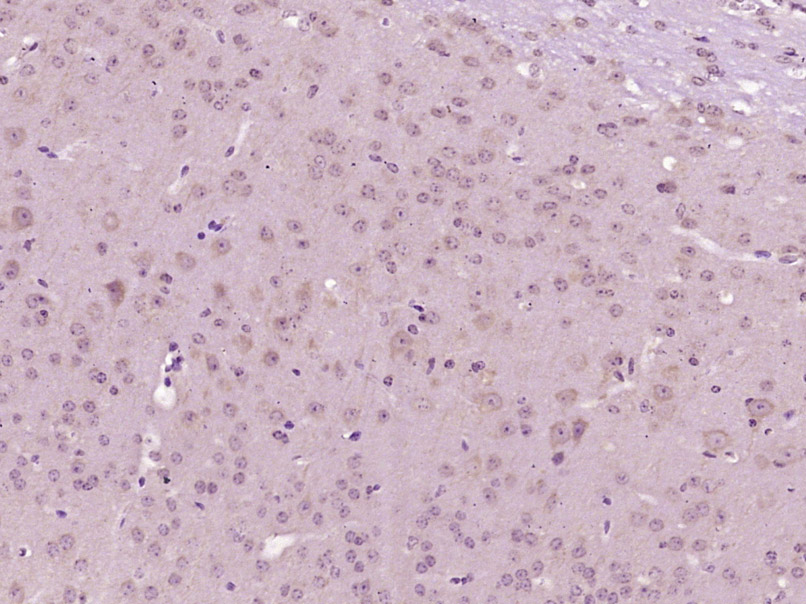
Rabbit Anti-Senataxin antibody
SETX; ALS4; Amyotrophic lateral sclerosis 4 protein; AOA2; bA479K20.2; DKFZp781B151; FLJ12840; FLJ43459; KIAA0625; Probable helicase senataxin; SCAR1; SEN1 homolog; Setx; SETX_HUMAN.
View History [Clear]
Details
Product Name Senataxin Chinese Name 肌萎缩侧索硬化症相关蛋白4抗体 Alias SETX; ALS4; Amyotrophic lateral sclerosis 4 protein; AOA2; bA479K20.2; DKFZp781B151; FLJ12840; FLJ43459; KIAA0625; Probable helicase senataxin; SCAR1; SEN1 homolog; Setx; SETX_HUMAN. Research Area Neurobiology Signal transduction Epigenetics Immunogen Species Rabbit Clonality Polyclonal React Species Mouse, (predicted: Human, Rat, Dog, Cow, Horse, Sheep, ) Applications WB=1:500-2000 ELISA=1:5000-10000 IHC-P=1:100-500 IHC-F=1:100-500 ICC=1:100-500 IF=1:100-500 (Paraffin sections need antigen repair)
not yet tested in other applications.
optimal dilutions/concentrations should be determined by the end user.Theoretical molecular weight 303kDa Cellular localization The nucleus cytoplasmic Form Liquid Concentration 1mg/ml immunogen KLH conjugated synthetic peptide derived from human Senataxin: 321-398/2677 Lsotype IgG Purification affinity purified by Protein A Buffer Solution 0.01M TBS(pH7.4) with 1% BSA, 0.03% Proclin300 and 50% Glycerol. Storage Shipped at 4℃. Store at -20 °C for one year. Avoid repeated freeze/thaw cycles. Attention This product as supplied is intended for research use only, not for use in human, therapeutic or diagnostic applications. PubMed PubMed Product Detail SETX belongs to the DNA2/NAM7 helicase family. Localizing to the nucleolus or the nucleoplasm in a cell cycle-dependent manner and to the cytoplasm, SETX contains a C-terminal DNA/RNA helicase domain and is believed to function as a helicase involved in RNA processing and DNA repair. Mutations in the gene encoding SETX can lead to ataxia-ocular apraxia 2 (AOA2) or amyotrophic lateral sclerosis 4 (ALS4). AOA2, also known as spinocerebellar ataxia-1 (SCAR1), is an autosomal recessive disorder characterized by progressive neurodegeneration of the cerebellum associated with the loss of Purkinje cells. ALS4 is a familial childhood- or adolescent-onset neurodegenerative disorder affecting both upper and lower motor neurons that ultimately results in fatal paralysis.
Function:
Probable helicase, which may be involved in RNA maturation. Involved in DNA double-strand breaks damage response generated by oxidative stress.
Subcellular Location:
nucleolus. Cytoplasm. May be detected in the nucleolus only in cycling cells (By similarity). Most abundant in the nucleus. Detected in granules. Colocalized in cycling cells with FBL in the nucleolus.
Tissue Specificity:
Highly expressed in skeletal muscle. Expressed in heart, fibroblast, placenta and liver. Weakly expressed in brain and lung. Expressed in the cortex of the kidney (highly expressed in tubular epithelial cells but low expression in the glomerulus).
DISEASE:
Defects in SETX are the cause of spinocerebellar ataxia autosomal recessive type 1 (SCAR1) [MIM:606002]; also known as ataxia-ocular apraxia 2. Spinocerebellar ataxia is a clinically and genetically heterogeneous group of cerebellar disorders. Patients show progressive incoordination of gait and often poor coordination of hands, speech and eye movements, due to degeneration of the cerebellum with variable involvement of the brainstem and spinal cord. SCAR1 is an autosomal recessive form associated with peripheral neuropathy and elevated serum alpha-fetoprotein, immunoglobulins and, less commonly, creatine kinase levels. Some SCAR1 patients manifest oculomotor apraxia.
Defects in SETX are a cause of amyotrophic lateral sclerosis type 4 (ALS4) [MIM:602433]. ALS4 is a familial form of amyotrophic lateral sclerosis, a neurodegenerative disorder affecting upper and lower motor neurons and resulting in fatal paralysis. Sensory abnormalities are absent. Death usually occurs within 2 to 5 years. The etiology of amyotrophic lateral sclerosis is likely to be multifactorial, involving both genetic and environmental factors. The disease is inherited in 5-10% of cases leading to familial forms. ALS4 is a childhood- or adolescent-onset form characterized by slow disease progression and the sparing of bulbar and respiratory muscles.
Similarity:
Belongs to the DNA2/NAM7 helicase family.
SWISS:
Q7Z333
Gene ID:
23064
Database links:Entrez Gene: 23064 Human
Entrez Gene: 269254 Mouse
Omim: 602433 Human
SwissProt: Q7Z333 Human
SwissProt: A2AKX3 Mouse
SwissProt: Q6PED8 Mouse
Unigene: 460317 Human
Unigene: 41867 Mouse
Product Picture
Bought notes(bought amounts latest0)
No one bought this product
User Comment(Total0User Comment Num)
- No comment



 +86 571 56623320
+86 571 56623320
 +86 18668110335
+86 18668110335

